Variations: Savory Pâte à Choux Dough and Filled Cream Puffs, Classic Eclairs
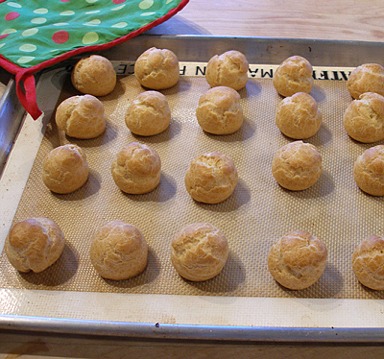
In French, choux means cabbage because it derives its shape when the dough is piped and baked into cream puffs. The goal in making the perfect cream pastry puff is to have the finest crispy crust, the lightest interior, and an even and golden browned shape. Making the Pâte à choux dough properly is the single most critical factor in any successful recipe. The dough is really a stable emulsion of fat and water, formed with the help of the yolk's emulsifiers. The dough is precooked and then baked. This recipe is used with the Croquembouche and Chocolate Eclairs recipes.
PASTRY RECIPE HELP
INGREDIENTS
1 recipe Pastry Cream Tutorial; make in advance and chill for at least 4 hours before using, so it can be nice and cold when you are ready to fill your baked puffs.
1 recipe Pate a Choux Dough, below
STEP II: MAKE THE CREAM PUFFS FROM PATE A CHOUX DOUGH
PATE A CHOUX DOUGH by Sarah Phillips
INGREDIENTS
3/4 cup cold water
8 tablespoons butter, 4 ounces; can be cold from the refrigerator
2 tablespoons sugar
Pinch salt
1 cup (about 5 ounces) unbleached all-purpose flour; spoon into measuring cup and level to rim; or more if needed
4 large eggs, must be close to room temperature; or more if needed
INSTRUCTIONS
Preheat the oven and prepare the pans:
1. Position an oven shelf in the upper and lower-middle levels of the oven and preheat the oven to 425 degrees F.
SARAH SAYS: A convection oven is ideal for choux pastry, yielding a more uniform color and puffiness. If using, bake at 50 degrees lower than the temperatures stated above.
2. Cover two baking sheets, preferably rimmed, with nonstick baking mats or parchment paper. Do NOT grease the pans; the grease will cause the dough to flatten.
NOTE: Rimmed baking sheets are best to use so the baked puff pastry balls do not fall from the pans when you remove them from the oven. You will need four pans.
Make the Pâte à choux dough:
1. Combine water, butter, sugar and salt in a 2-quart heavy bottomed saucepan. Place it over medium heat.
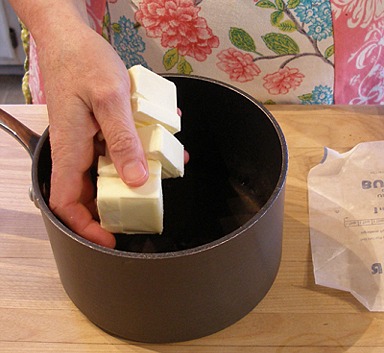
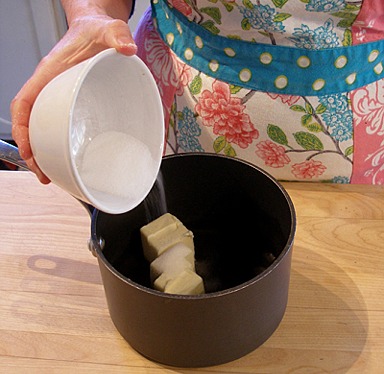
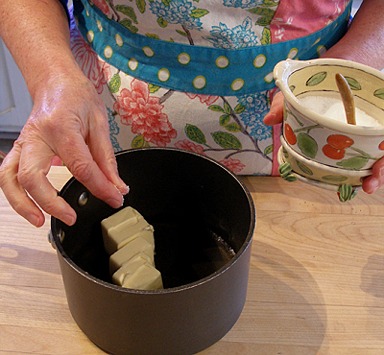
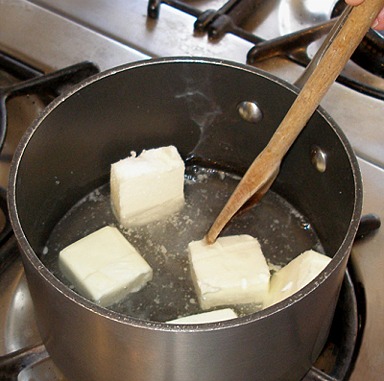
Cook, stirring occasionally with a wooden spoon, until the butter melts and the liquid is brought to a rapid boil. Immediately remove the saucepan from the heat
2. Immediately sift in the flour all at once.
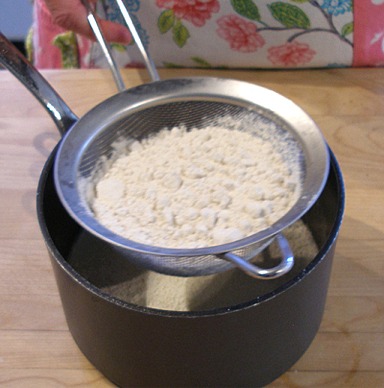
Beat with a wooden spoon until smooth.
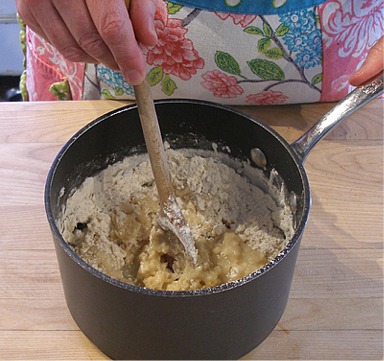
3. Return the saucepan to medium heat and cook for about 3 to 5 minutes, beating constantly with a spoon. This is to evaporate all excess moisture from the mixture.
While you cook the paste, flatten and turn the dough against the sides of the pan, drying the paste as much as possible.
The dough will form a cohesive ball in the center of the pan even after a few strokes. Note that the bottom of the pan will become lightly filmed with the paste.
Cook and stir until the mixture holds together and begins to leave the sides and bottom of the pan clean.
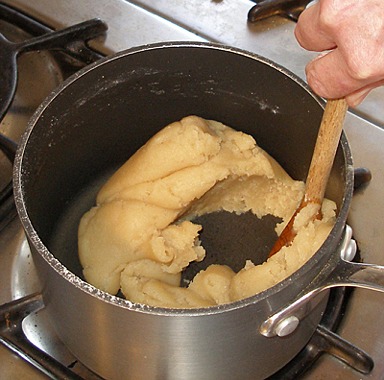
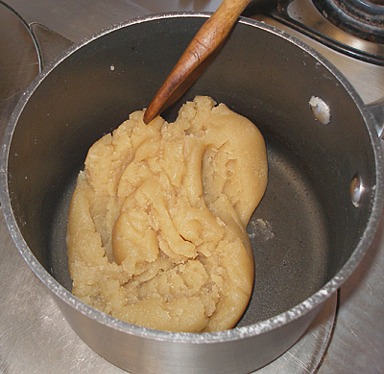
SARAH SAYS: Avoid overcooking the paste and letting the fat (oil) eparate out from the butter.
4. Transfer the paste, without scraping the bottom and sides of the pan, in case there is any pastry film on it, to a 2- to 3-quart bowl or the bowl of an electric mixer.
Fit the mixer with a paddle attachment and beat on the lowest speed for 1 minute or until it cools slightly before you add the eggs.
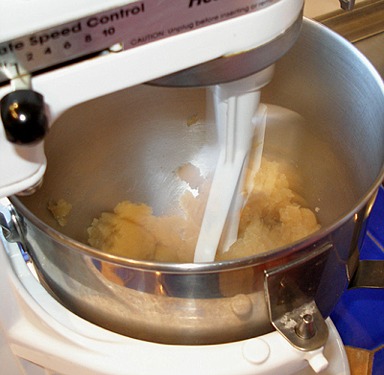
5. The eggs should be close to room temperature.
With the mixer on low, add them to the one at a time, beating well after each addition, to prevent the mixture from breaking and separating.
The dough will appear slippery at first but will become sticky and then smooth again as you continue to mix. The dough will be warm.
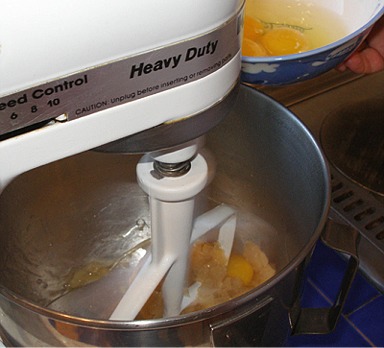
6. After all the eggs are incorporated, stop the mixer, and the dough should hold its shape and be stiff enough to hold a peak when the paddle attachment or a spoon is lifted out of it.
It will also still be somewhat sticky from the eggs.
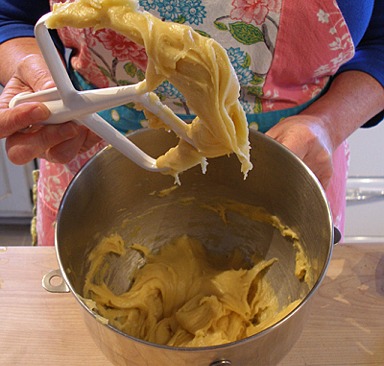
When you have added the last egg, pinch off a small bit of dough with your thumb and index finger, and pull it apart. If it stretches between your thumb and finger, it is at a good consistency.
If it breaks apart right away, add another egg and beat to incorporate. If the dough is too soft, it will spread out when formed; add a teaspoon of flour at a time to the mixture and beat on low to stiffen.
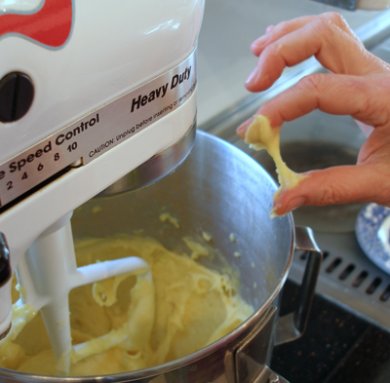
Form Pâte à choux dough to be baked:
1. Place the batter in a large pastry bag fitted with a 1-inch plain tip. Pipe into circular blobs, about 1 1/2 inches in diameter, onto the prepared pans.
Leave 2-inches between the puffs to permit adequate expansion from puffing.
NOTE: Or, quickly spoon the Pâte à choux dough by the rounded teaspoonfuls.
Proceed as quickly as possible so the Pâte à choux dough is still warm when it enters the oven. Cold choux pastry will also be stiff and harder to pipe.
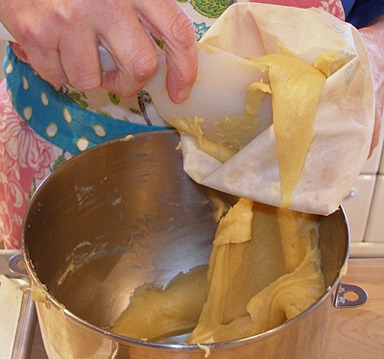
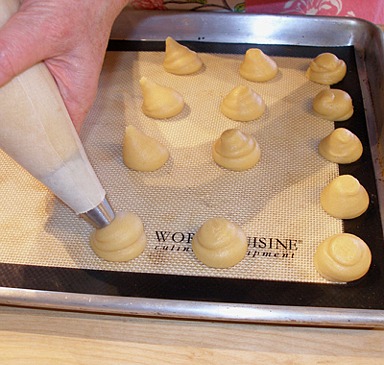
NOTE: If your puffs have a little peak at the top, after you pipe them, dip a finger in water and gently tap it down.
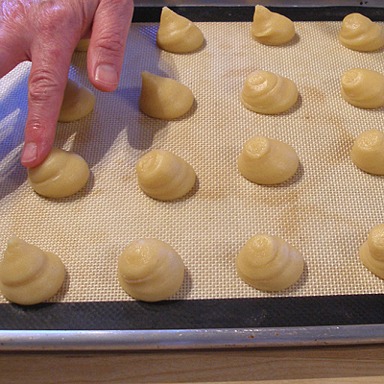
2. For best results, bake the dough immediately after it's formed in a well-preheated oven. This will ensure the greatest expansion and lightness.
Bake the formed choux dough:
1. Place the filled baking sheets in the upper and lower-middle levels of the preheated 425 degrees F oven or until the puffs are beginning to color, about 10 minutes.
2. Lower the temperature to 350 degrees F until well browned and dry, about 20 minutes.
To check, a wooden skewer inserted into the center should come out dry.

SARAH SAYS: A properly baked choux retains its puffy shape, with a hollow interior with an outside that is crisp and fairly dry, with an all over golden color. When broken apart, it should have a slightly moist crumb on the inside. However, if they are removed from the oven too soon, the structure of the shell has not solidified, and it will collapse. However, when you think they are done take one out of the oven and check it by breaking open and checking the interior walls. If wet and eggy, return to the oven as necessary.
3. Remove when done. IMPORTANT: After removing the pastries from the oven, immediately puncture them on the side or bottom with the tip of a sharp knife to allow steam to escape. This will prevent sogginess.
Place them on a wire cake rack to cool. Serve or use immediately.
STORAGE
If you have more dough than you need, form and bake all of it and freeze the excess finished puffs. Wrap the baked shells tightly after they have cooled. Thaw, unwrapped on a wire cake rack to prevent sogginess.
STEP III: FILL THE BAKED CREAM PUFFS WITH PASTRY CREAM
Work quickly; once filled with pastry cream, the baked cream puffs will absorb some of the moisture from it, becoming very soft if they're allowed to sit too long before using.
You do not want to use soggy puffs for the Croquembouche Recipe because it will collapse.
1. Take the chilled pastry cream from the refrigerator and stir it a few times. Line two baking sheets with parchment paper.
2. Fill a pastry bag, fitted with a 1/2 inch tube, with pastry cream.
3. Pipe the cold pastry cream into each puff, them set the filled puffs on the prepared baking sheet.
KELLY CA SAYS: I fill the puffs using the same hole that I made when I pricked the side of the puff to allow the steam to escape.
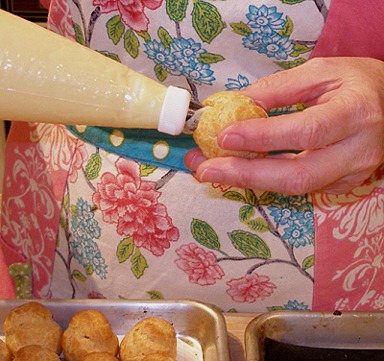
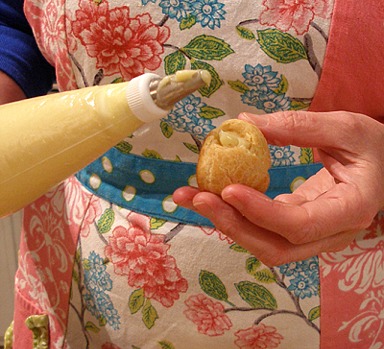
4. Cover and place the filled cream puffs into the refrigerator.
STORAGE
If filled with pastry cream refrigerate immediately and serve within two hours. They cannot be frozen.
They can be filled chocolate ganache, as well. If stored longer, the cream puff shell gets soggy. Refrigerate: Up to 1 to 2 days, at the VERY best.
VARIATIONS
Savory Pâte à Choux Dough and Filled Cream Puffs – Omit the sugar, decrease the butter to 6 tablespoons (3 ounces) in the dough recipe
Use a savory filling, such as our Salmon Wasabi Cream Cheese Filling.
Classic Eclairs


